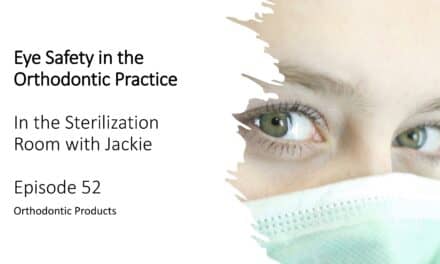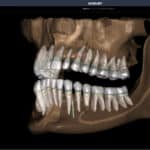Summary: Many large, multi-office orthodontic practices and OSOs are hindered by outdated, disconnected technology that reduces efficiency and limits growth. In this episode, Eric Giesecke, CEO of Planet DDS, discusses how cloud-based, open-platform practice management solutions and AI-driven tools can help orthodontic businesses streamline operations, improve patient experiences, and drive profitability in 2025.
Key Takeaways:
- Outdated technology creates inefficiencies that slow practice growth and limit profitability.
- Open-platform solutions allow orthodontic practices to integrate new innovations without disrupting daily operations.
- AI-powered automation will simplify practice management by reducing manual tasks and improving data accessibility.
As orthodontic practices move through 2025, the pressure to drive revenue growth is stronger than ever. However, many large multi-location groups and orthodontic support organizations (OSOs) continue to struggle with outdated technology that limits efficiency, restricts data access, and impedes scalability. In this episode of The Orthodontic Products Podcast, host Alison Werner speaks with Eric Giesecke, CEO of Planet DDS, about how cloud-based practice management systems, open-platform technology, and AI-driven tools are transforming orthodontic operations.
The Pitfalls of Outdated Technology
Many orthodontic practices are operating on legacy systems that create fragmented data silos, making it difficult to maintain consistent workflows and patient experiences. According to Giesecke, practices relying on multiple disconnected platforms struggle to extract meaningful insights, standardize operations, and implement emerging innovations. These inefficiencies not only hinder growth but also lead to frustration for both providers and patients.
Three Strategies to Improve Profitability in 2025
One of the most effective ways for OSOs to improve profitability is by embracing open-platform technology. Unlike traditional closed systems, modern cloud-based practice management software—such as Cloud9—allows seamless integration with third-party applications and AI-powered tools. This flexibility ensures that practices can incorporate new innovations without overhauling their existing workflows, allowing them to stay competitive as technology advances.
A patient-centric approach is another critical factor in driving growth. As consumer expectations evolve, orthodontic practices must prioritize digital communication tools, automated appointment reminders, and AI-assisted treatment planning. Enhancing patient engagement through these technologies not only improves satisfaction but also increases case acceptance rates and strengthens long-term patient relationships.
Data-driven decision-making is also essential for large practices seeking sustainable growth. A centralized software platform allows OSOs to standardize processes across locations, track performance trends, and make informed strategic decisions. By leveraging a single source of truth for patient data and financial analytics, practices can streamline operations and identify opportunities for increased efficiency.
The Role of AI in Orthodontics
Looking ahead, Giesecke highlights the increasing role of artificial intelligence in orthodontic practice management. AI-powered automation is expected to enhance efficiency in areas such as cephalometric tracing, financial reporting, and administrative workflows. Additionally, AI-driven voice commands and predictive analytics will make it easier for orthodontists to navigate complex software, reducing the time spent on manual tasks.
Lessons Learned from This Podcast
-
Technology should be a growth enabler, not a barrier – Modern platforms eliminate inefficiencies and support seamless scalability.
-
AI-driven automation will streamline operations – From ceph tracing to financial workflows, AI is enhancing practice management.
-
Selecting the right software partner is crucial – A flexible, open, and scalable system is essential for long-term success.
As the orthodontic industry continues to evolve, investing in the right technology will be a decisive factor in maintaining profitability and delivering high-quality patient care. OP
Podcast Transcript
Alison Werner (00:05)
Hello and welcome to the Orthodontic Products podcast. I’m your host, Alison Werner. As we start the new year, I know you all want to see revenue growth in 2025, but struggle with how to do things differently to really impact change, especially if you’re a part of a large practice or orthodontic support organization. But here’s where technology can come in. So to help us unpack this, we have Eric Giesecke CEO of Planet DDS, which is the provider of Cloud9 OrthoPractice Management, Apertx Cloud Imaging, and Legwork Practice Marketing platforms.
We’re going to talk about how many practices are held back by broken, outdated, and siloed technology systems that are hindering growth and also the business practices related to technology that your large practice might be missing out on that could really make a difference in improving practice profitability in 2025. Eric, thank you for joining me.
Eric Giesecke (00:50)
Alison, so thank you for having me. So glad to be here.
Alison Werner (00:53)
Great. can you talk, before we get started, can you talk to me a little bit about your background and your role at Planet DDS?
Eric Giesecke (00:58)
Sure. I am the CEO at Planet DDS. I’ve been the CEO here for nine years. I joined the company through what’s called a search fund, which is a small kind of private equity vehicle intended to buy and operate a single business. were 25 employees working with just a couple of large DSOs at the time. We grew the business pretty substantially while working more on the general dentistry side. And then we’re fortunate enough about two years ago to acquire a platform called Cloud9, which is a
cloud-based, ortho-focused, practice management software. We work with some of the largest OSOs, like Smile Doctors, My Orthos, and such. So as CEO, responsible for lots of different strategic type stuff, but get a chance to interact with all the customers we have. We’re at about 13,000 locations across the US. But yeah, we’re very focused and very excited about the orthodontic marketing, kind of how it’s shifting from.
Alison Werner (01:55)
So let’s dive into that. What are the main ways outdated systems related to technology are holding back orthodontic practices?
Eric Giesecke (02:04)
Yeah, so I think it’s really kind of three things. One is legacy systems really create data silos. They reduce operational efficiency and they really limit adaptability to new technology trends. like if we’re, if you’re an OSO and you’re scaling and growing and you’re on lots of different platforms, those platforms don’t necessarily speak to each other. It’s very hard to pull data. Patients sometimes who travel between offices and providers don’t always have access to all the information at other locations. So it really makes it challenging to maintain consistent workflows and data continuity.
Alison Werner (02:22)
Yeah.
Eric Giesecke (02:34)
I’d say the third thing is like patient education or patient expectations are changing, particularly as the demographics are shifting and younger people who really, think from a general dentistry and orthodontic perspective and their parents, and particularly when it comes to ortho, are really expecting a very seamless and easy customer or patient experience. And it’s sometimes hard to do that with some of the legacy software. The more modern architectures, the more modern platforms of which we’ll talk about, I’m sure, in a second.
They really focus a ton on making sure that patient and parent experience in the case of ortho is really responsible party is really quite seamless.
Alison Werner (03:10)
Okay, so then let’s start with what are three actionable ways that OSOs and large practices can boost profitability in 2025 better related technology? Because I know that goes into a little bit of the problems you were talking about there.
Eric Giesecke (03:23)
Yeah, so I think the first one is really being open to adopting flexible technology. So as practice management systems standardize in ortho, it’s really important that the practice management solution, the system of record that people choose are flexible enough to allow you to use and take advantage of innovation that happens outside the core software. we have a bunch of things called APIs, they’re connectivity kind of points between our software and other applications. And to have a platform
that allows you to tie into those things, take advantage of some of the AI tech data that people are solving, some of the problems that people are working on, and be able to consume that data within the platform and the workflows you work in every day is super critical. there’s a ton of, everyone knows there’s a ton of issues technology-wise, I think in any industry, particularly in ortho, there are lots of really kind of innovative and nimble companies that are solving them. You want to be with a platform, I think, that allows you to take advantage of those applications. That’s the first.
The second thing is think focus on really patient centric enhancements. I think this is going to be more and more critical. How you communicate with the patients, how you send reminders, how you present treatment, how you think about starts and all of those type of things. How do you remarket to folks? I think that’s critical so that you can drive revenue, bring new patients into the practice and make sure that the features kind of align along patient expectations with satisfaction and loyalty and such.
The third one I think, and it drives again to the notion of being on a platform, it’s as you scale and as you grow, and particularly as everybody who’s in an OSO, has acquired offices has known, a controlled growth is something we all strive for. And the data-driven insights you can get on being a single platform, a single technology platform, to be able to pull the trending data in one office versus another office, or to be able to evaluate specific kind of things that you want to between different systems.
Alison Werner (05:14)
Mm-hmm.
Eric Giesecke (05:14)
it’s critical
to be on a single platform because it allows you to do that quickly and react nimbly to that, which I think is super critical to profitability, particularly as you scale. If you’re on a bunch of different platforms and they don’t speak to each other, you lose a little bit of control about the standardizing of the patient experience, but also on the data required to be effectively run a growing organization that I think being on a platform really helps.
Alison Werner (05:24)
Yeah.
Well, you mentioned there about open platforms with the API. How does adopting an open platform, can you go a little more depth? How does that really help an orthodontic group overcome kind of these common industry challenges?
Eric Giesecke (05:48)
Yeah,
great question. I think when you think about the orthodontic practice management software, traditionally, there’s a philosophy I think some groups have had or some companies, software companies have had, they want you to do everything within the software, right? So they want you to, they want to kind of have as much of the experience reside within the practice management software. So our philosophy is different. And I think in situations where you have rapid technological change, like what’s happening in orthodontics.
You have lots of individual companies that are solving problems that you either you can’t take advantage of those because at the end of the day, people want to operate in the core system of record that they’re in all day. They don’t want to move from, you know, cloud nine or fourth of software to another platform. They want to they want to actually consume the information in the past. So being an open platform allows you to get the both best of both worlds. You get to be in the system that you like to operate in every day that you’re used to and change management, of course, is super hard.
Alison Werner (06:35)
Mm-hmm.
Eric Giesecke (06:44)
but you also get the insights, technology, and problems that are being solved by other platforms. We’re just connecting through the data through the API. So it gives you the ability to be in a single platform but still take advantage of innovation.
Alison Werner (06:56)
Okay, so when a practice is evaluating new technology, what should an OSO or a large practice prioritize to kind of ensure long-term success?
Eric Giesecke (07:08)
So I think it is, I think when you think about the practical management software use, it’s super critical. It has to be the right partner. has to understand what your needs are. It has to be, it has to, I think, be flexible and open in the way we discuss when it comes to being a platform. It has to be scalable. So I think you want, you pick a partner that has shown and demonstrated the ability to support organizations that you might aspirationally want to look like, larger OSOs. If you’re multi-specialty OSOs and DSOs, the capability of being able to intertwine.
Practice Management software, traditional with multi-specialty with Ortho. You want to make sure that the platform has developed very strong centralized data management so that you can either draw the data, data warehouse it, provide the reports and insight you want. Again, back to the idea of being on multiple different bespoke systems and those data not necessarily talking to each other. How you think about managing your business to get visibility into all the individual locations is critical.
And then the last thing I would say is probably interoperability, which ties a little bit to flexibility in terms of open API. But I think as practice management software evolves or technology evolves, it’s going to be more critical. And you can see this in some other health care verticals that are a little bit more mature than orthodontics. You start getting in areas that are very, very good at specializing on one aspect of a patient journey. So for example, it might be around converting starts.
Like maybe you want to do that with a very unique system that is really, really slick at doing that, but you don’t want to switch off your practice management software. That interoperability, the ability for those two things to connect together and give you the flexibility to use what you want is massively critical. And I think the problem is, it’s like switching practice management software is hard. It is like, I don’t think we’ve, we try very hard to be, make it less painful, but it is. And so once you make that decision, right, to move into partner with somebody,
Alison Werner (08:51)
Mm-hmm, yeah.
Eric Giesecke (08:56)
You’re not stuck, you can always switch, but nobody wants to. So you have to make sure you pick a partner that’s aligned with, I think, what you want to do. And I think the smart OSOs are ones that want to take advantage of all the innovation that happens outside.
Alison Werner (09:09)
Okay, so speaking of innovation, AI is a big topic of conversation across all industries. So what innovations do you think will shape orthodontic practice management over the next few years and where does AI fit into that?
Eric Giesecke (09:22)
Yes,
I think that’s a great question. there’s a lot of, obviously, stuff happening with ceph tracing and some of the AI stuff for the imaging software that you’re starting to see develop. I think there are, there’s a lot of AI innovation in terms of ways that people are thinking about interacting with software. An example might be, I think this is true for all vertical software applications. The way we currently interact with the software application is that we click a mouse, we type in something, and oftentimes we have to click around, we don’t know where to go. it’s, particularly when you have robust…
Alison Werner (09:28)
Mm-hmm. Right.
Eric Giesecke (09:52)
software like ours, it’s difficult to be able to kind of use the software know where to go. I think the world is going to move where AI is going to help you predict some of that stuff. in other words, if you wanted to get a list of all patients for owe you and outstanding balance to send them a notice, right? Right now in software, you go in, you find the report, you create the segment, you create the list, you send them all a text message. It’s 10 steps. And you have to know how to do all those 10 steps on her due to practically what if you were able just to, you know, basically even speaker type and say,
give me a list of all patients that owe me money, send them a text message. So how you interact in the AI applications, the backend AI large language models of which are innovating across all different types of vertical software are going to make it so much easier for you to be able to ultimately get the outcome of what you want without having to understand and know how to use every aspect of the software application. I think that that’s the case in our software. It’s a case across the board, but I think it’s massively exciting in terms of what AI is doing.
Alison Werner (10:25)
Mm.
Yeah.
Okay, so what is the main takeaway you’d like OSOs and large group practices to gain from this conversation?
Eric Giesecke (10:56)
So I think it’s, I think get on my opinion, I’m a biased because it’s what we do for a living, but I think being on a standardized platform is massively beneficial if you’re trying to operationalize, standardize, ensure consistent and high quality patient care, be able to grow. Like I think it’s, there’s never a good time to take the pain of switching software. The sooner you do it in your growth journey, the easier it is because once you’re on a platform, whether it be our platform or another.
It makes it so much easier to add that incremental office and makes the integration of that office so much easier. It also allows you to kind of, again, be able to use different technology if the philosophy of the practice management software is to be open. I think it’s like that, my recommendation I take away is like, I think everybody in their strategic planning should be evaluating when to do that and how to do that. And when ultimately you decide to move to a platform.
Be super thoughtful, check references, but make sure you pick a partner that is open to allowing you to use the things that you want to use going forward. And don’t try to control all of the user experience within its application. Because you don’t want to get stuck in a closed system where this really cool software exists over here and suddenly you find out you can’t use it because the data they require to operate exists within your practice management software. So be thoughtful and philosophically aligned in terms of the partner you choose.
Alison Werner (12:02)
Yeah.
Well, Eric, thank you so much for taking the time to talk to us and sharing your knowledge on this. think it’s really important and should have some impact with making decisions about technology in the year ahead. Thank you.
Eric Giesecke (12:23)
Great. Thanks, Alison, for having me.













